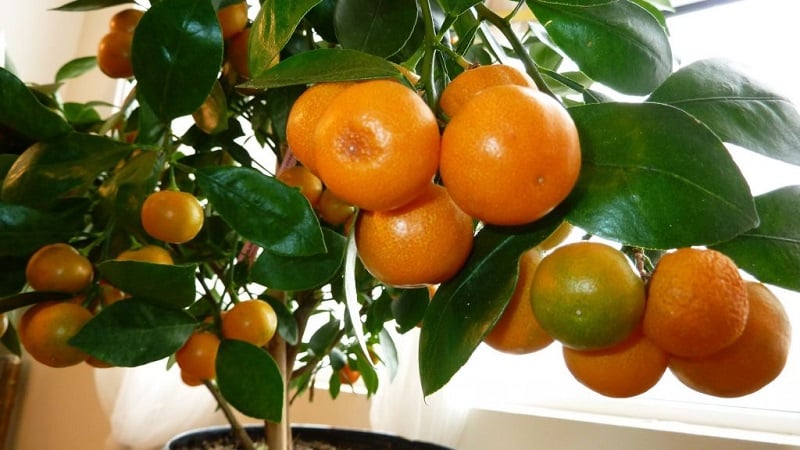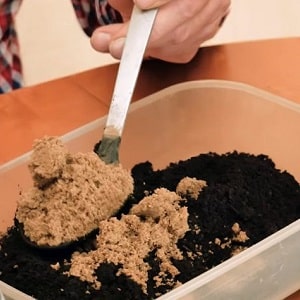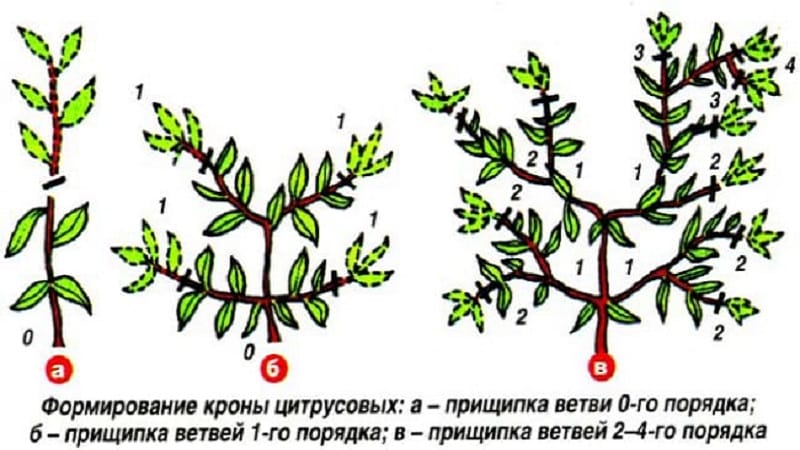Rules for growing tangerines from seeds at home
The tangerine tree is often grown as a houseplant. It looks attractive all year round with green, leathery, glossy leaves, delicate white blossoms and bright orange fruits. The tree is distinguished by its rich aroma, which has a beneficial effect on health.
Mandarins are propagated by vegetative and generative methods. The latter method is simpler - it allows you to obtain hardy plants that are resistant to negative factors and diseases. Read on to learn more about how to grow tangerines from seeds at home.
Features of growing tangerine from seed
Growing tangerine from a seed at home is possible. This the tree will be characterized by increased resistance to negative environmental factors and undemanding to the composition of the soil.

The disadvantage of the generative method of mandarin propagation is that The seeds produce plants that look attractive, but are distinguished by smaller fruits with pale skin and a sour, tart taste. But their aroma is more intense.
When growing tangerine take into account that it germinates more slowly than other citrus plants. Often a tree stops growing for a while, but with proper care it soon resumes development.
This is interesting! Unlike other citrus fruits, tangerine cuttings do not take root well.
There is often information that real tangerines do not have seeds, but hybrids do. This is not always true. There are no seeds in Satsuma and Unshiu fruits. They are sold under the name “Abkhazian tangerines.” Some hybrids are also seedless.
Preparing for landing
To grow an indoor tangerine tree in a pot from a seed, preparatory work is first carried out. The correct selection and preparation of planting material and soil determines whether the seeds will germinate and whether the sprout will survive.
Selection of planting material
When choosing fruits for planting material, it is difficult to determine which fruits have seeds. The easiest option is to ask the sellers. Another way to get planting material is to buy tangerines of different varieties.
Note! Tangerines with seeds are usually cheaper than without them.
To obtain planting material, fruits must be ripe and evenly colored, free of stains, rot, mold and other signs of disease.
The collected seeds are sorted. Suitable specimens for planting must meet the following requirements::
- Shape and size. The seeds should be voluminous, pot-bellied and large. It is better to immediately discard small and deformed planting material. The first sign indicates that the seeds have not formed, and the second indicates that they have not formed correctly.
- Hardness. The seeds should be dense and hard to the touch, without damage. Dried and soft specimens are not suitable.
- Appearance. The seeds are light, with a uniform color. Seeds with a blackened tip, green spots, mold and other signs of disease are not suitable.

Even if you plan to grow only one tree, take at least 10 seeds, since not all of them will germinate, and some sprouts will die. If grafting is planned, it is better to grow several trees at once in case the procedure is unsuccessful.
Rules for preparing seeds
The collected seeds are used immediately. They are not dried, as this negatively affects germination.
Before you grow a tangerine from a seed at home, seeds are prepared:
 Disinfection. Planting material is soaked for half an hour in a light pink solution of potassium permanganate or hydrogen peroxide.
Disinfection. Planting material is soaked for half an hour in a light pink solution of potassium permanganate or hydrogen peroxide.- Soak. To allow the seeds to swell before planting, they are wrapped in gauze and placed in a saucer. The gauze is moistened with warm, settled water, covered with film and put in a warm place. The seeds are left in this form for a day.
- Stimulation of growth. A day later, the gauze is watered with a solution of a growth stimulator (Epin, Mortar). The seeds are left in this form for another 24 hours.
Tangerine seeds swell within 48 hours. It is extremely rare to germinate in such a short period.
Some gardeners plant seeds without pre-soaking. In this case, they take longer to germinate.
Preparing soil and containers
Tangerines are picky about soil composition. Not suitable for them soil mixture with peat. This component increases the likelihood of sprouts rotting. That is why it is not recommended to use purchased universal primers.
 It's best to prepare the soil yourself. To do this, mix:
It's best to prepare the soil yourself. To do this, mix:
- humus - 2 parts;
- river sand – 1 part;
- forest or garden soil - 2 parts.
It is recommended to check the acidity of the soil using litmus paper. If the soil is acidic, ash is added to it, since tangerine loves a neutral environment.
When growing tangerines, drainage is used. Small crushed stone, special glass balls, broken dishes, crushed bricks, etc. are placed at the bottom of the pot.
Soil and drainage are disinfected: calcined in the oven, poured with a dark pink solution of potassium permanganate or doused with boiling water.
The seeds are planted in one common container or in individual pots. The first option is more economical, since not all seeds will germinate. Used as containers for germination:
- the lower part of the cut bottle (the upper part will be used to create a greenhouse);
- the bottom part of a cake package (the top part is also used to create a greenhouse);
- a plastic cup.
Drainage holes are pierced in the bottom of the germination container.which will prevent moisture stagnation. The container is disinfected by soaking for 30 minutes in a dark pink solution of potassium permanganate or wiping with alcohol.
Rules for planting tangerine seeds
When everything is prepared, proceed to planting the seeds.
How to plant a tangerine:
- A layer of drainage is poured onto the bottom of the container, soil is placed on top and watered with warm water.
- Seeds are planted in the ground, deepening them by 2-3 cm.
- The soil with the seeds is watered again, and if the seeds become visible, they are covered with earth.

Containers with crops are covered with film or transparent plastic and put in a warm place (+20…+26°С) away from direct sunlight.
Interesting! Orange seeds can germinate without a greenhouse. Then the shoots will appear later, but they will not have to be accustomed to the conditions in the apartment.
Crop care
Before picking, crops need care:
- Watering. Tangerines are watered with warm, settled water - chlorine is harmful to them. Before the seeds germinate, the soil is moistened daily with a spray bottle so as not to erode the soil.The emerging shoots are watered from a watering can with a narrow spout for ornamental plants and the sprouts are sprayed with a spray bottle.
- Ventilation. Every day the greenhouse is opened slightly for 30 minutes to ventilate the plantings.
- Temperature. At this stage, the room temperature should be within +20...+26°C.
- Hardening. After the seeds germinate, the duration of ventilation is increased daily by 30-40 minutes. Gradually this time is increased to a day, and the greenhouse is dismantled.
After germination, the pot is moved to the windowsill. At this stage the plant will need more light.
Note! The first shoots usually appear 2-4 weeks after planting. Sometimes the germination process takes longer.
Picking
When 2-4 leaves appear on the seedlings, they are picked into individual containers. For transplantation, choose the best planting material with the following characteristics:
- bright green color;
- good turgor;
- strong stem;
- large leaves.

Yellow and wilted sprouts are removed. If 2 sprouts appear from one seed (tangerine is characterized by the phenomenon of two germs in one seed), the weaker one is pinched. If both plants are well developed, their root systems are separated and planted in different pots.
This is interesting! Mandarin oranges do not have cotyledon leaves.
Step-by-step instructions for picking:
- Choose a clay or ceramic container with a diameter of 5-6 cm. It is disinfected.
- A layer of drainage and soil are poured onto the bottom of the pot. The soil is watered with warm water.
- Healthy seedlings are removed from the common box with a fork, ice cream stick or toothpick.
- They are transplanted into a pot without deepening the root collar.
- The soil is watered again, and the plants are sprayed with a spray bottle.
Until the sprout takes root, it is held in a bright place, but protected from direct sunlight.
Rules for caring for tangerine
After transplantation and throughout life, the tangerine needs care. This is an unpretentious tree, but if you skip watering and fertilizing, there will be no flowering or fruits.
In order for the tree to bear fruit, the rules of care must be followed.
Temperature
Before flowering, the temperature in the room where the tangerine grows is maintained within +20...+26°C. When the plant blooms, the indicators are reduced to +18...+19°C so that it does not drop its flowers. In winter, tangerine feels good at a temperature of +10...+12°C.
Lighting
In the warm season, tangerines need light and protection from direct sunlight.. To ensure optimal conditions for growth, the pot is placed on an eastern or western windowsill. In winter, the tree does not require additional lighting, as it is at rest. If possible, during the cold period the pot is moved to the southern windowsill.
Humidity
Tangerine needs a humid environment. Its leaves are sprayed daily with a spray bottle. In winter, the air is drier, so additional humidification will be needed. Place an air humidifier or a container of water near the tree.

Watering
In the warm season, tangerines are watered daily with warm, settled water.. In winter this is done less often, 1-2 times a week.
Advice. To simplify caring for tangerines, use bottom watering. To do this, pour water into the tray under the tangerine tree pot.
Transplants
Before the first fruiting, tangerines are replanted annually. into a pot that is 4-5 cm larger than the previous one, along with a lump of earth, filling the missing volume with soil. Plants that bear fruit are replanted once every 2-3 years, removing dry roots. Old trees are not replanted.In this case, once every few years the top layer of soil in the pot is removed, replacing it with new soil.
Feeding
Mandarin feed 1-2 times a month. Alternate complex and mineral fertilizers. They buy special products for citrus fruits or prepare their own fertilizers from chicken droppings, herbal and fish decoctions, ash, vegetable peelings or tea. In winter, the tree is not fed.
Loosening
The soil is loosened at least once a week to normalize root air exchange, prevent moisture stagnation and prevent the appearance of earthen pests.
Cleaning
To clean leaves from dust, once a week they are wiped with a damp cloth. Once a month, tangerines are washed in the shower.
Bloom
If the tangerine blooms in the first 2 years after planting (this is rare, but it happens), all the inflorescences are cut off, otherwise the tree will waste energy on flowering and die. During the first flowering, several flowers are left on a plant older than 2 years. Mandarin does not need artificial pollination.
Fruiting
During the first fruiting, only one fruit is left. The next year, 2-3 oranges are left on the tree. Further, the ovaries and fruits are not cut off.
Reference. Some gardeners, in order to speed up the growth of tangerine, care for it equally in the warm and cold seasons before the first flowering. Then the plant does not go dormant in winter.
Trimming
This procedure prevents tangerine disease and brings fruiting closer. There are two types of pruning - sanitary and formative.
Sanitary pruning involves the removal of diseased, dry, weak and old parts of plants. The branches are cut with sharp pruning shears, covering the cut areas with garden varnish.
Formation stimulates the formation of new shoots, allowing for faster fruiting. This procedure ensures a neat crown.

Step-by-step instructions for crown formation:
- When the plant reaches a height of 40-60 cm, the growth point on the main trunk is pinched. This activates the formation of side shoots.
- Side shoots of the first order are cut off after 4-5 leaves. Shoots of the following order will form in the axils of these leaves. In this way, all branches up to the fifth order are formed.
- It is recommended to leave 3-5 branches of the same order on the tree. Such shoots should be directed in different directions.
Fruits are formed on branches of the 4th-5th order. It takes 3-4 years to form.
Diseases and pests
Despite the fact that tangerines grown from seeds have high immunity to diseases, pests still attack them. Among them, the most common:
- aphids - small black or green insects on the undersides of leaves and shoots;
- scale insects - convex plates on branches;
- spider mite - small dots and cobwebs on the underside of leaf blades;
- Mealyworm – areas of white fluffy growth on a plant.
Affected trees are washed in the shower and then sprayed weekly with a soapy solution. until the problem disappears. To combat scale insects, add a little kerosene to the soap solution. If the home remedy does not help, use insecticides “Vertimek” and “Sunmite”.
When to expect first fruiting
Mandarin begins to bear fruit after 3-5 years. Plants grown from the seed produce small fruits with a sour taste and light skin.
To get real tangerines, the tree vaccinate. To do this, use a scion of a citrus hybrid that has already bear fruit and was grown vegetatively.
When grafting a tangerine in the first year, all the greenery of the plant is cut off, leaving only part of the trunk, which will be the rootstock. Some gardeners graft one or more branches.
Grafting material is purchased at gardening stores or cut from an already fruit-bearing tree. Sometimes stores sell tangerine fruits along with twigs - they are also suitable for grafting.
Conclusion
Tangerines are often propagated generatively, growing from seeds. This is the most affordable method, since you can plant seeds from fruit purchased at the grocery store. Despite the fact that tangerine takes longer to germinate and takes root less well than other citrus fruits, it is not difficult to care for.